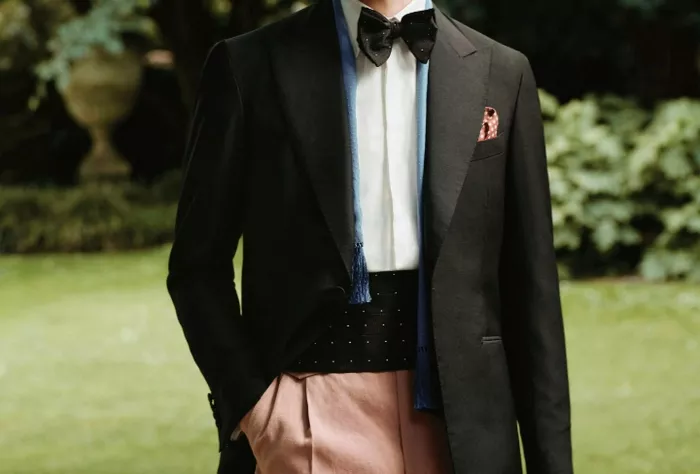Simon Holloway, appointed as creative director of British luxury house Dunhill in April 2023, is reshaping the brand’s heritage with a fresh yet respectful touch. With a résumé that includes design leadership roles at James Purdey & Sons, Agnona, Ralph Lauren, and Narciso Rodriguez, Holloway brings decades of refined taste to Dunhill—an iconic label that began in 1893 when Alfred Dunhill turned his father’s saddlery into a symbol of British sophistication rooted in motoring culture.
Today, as part of the Richemont luxury group, Dunhill has transitioned from its roots in automotive accessories to become a premier menswear brand. Holloway fully embodies this dual identity, moving with ease between the worlds of rock stardom and royal refinement. His design philosophy treats elegance as a foundational value while favoring a lighter, more casual approach. He deliberately steers clear of the stiffness often associated with traditional Savile Row tailoring, preferring a joyful and accessible sensibility. “I like being someone who makes people’s lives easier, rather than complicating them,” Holloway explains.
Reflecting on his new role, Holloway described the experience as deeply personal. Joining Dunhill felt like connecting with the legacy of his father, a well-traveled man who wore blue blazers and represented a quintessentially British aesthetic. To Holloway, Dunhill has long been a pinnacle of menswear.
The brand’s rich legacy began with Alfred Dunhill’s early understanding of the automobile’s cultural significance and the subsequent need for refined accessories and garments. Post–World War II, Dunhill became synonymous with sharp tailoring that defied the rigid standards of Savile Row. Iconic figures such as Frank Sinatra and Truman Capote helped cement this identity, particularly through events like the Black and White Ball in 1966. Today, Holloway says the brand continues to blend classical British wardrobe codes with nearly four decades of Italian tailoring finesse. The result: lightweight jackets with defined but unpadded shoulders and silhouettes that strike a balance between traditional English proportions and modern comfort.
For a generation that may have never worn or even seen a proper suit worn by their parents or grandparents, Holloway sees opportunity. He acknowledges a cultural shift where younger people are rediscovering formalwear as a tool for self-expression rather than obligation. In his words, it represents a “counterculture” response to the extremes of casual fashion. In London, for example, many young individuals are choosing vintage or custom-made suits—or turning to brands like Dunhill—and pairing velvet jackets with jeans. “They have no rules, and I find it very inspiring,” he notes.
Holloway also believes the suit has broken free from the confines of boardrooms. He recalls a story of a bassist from a prominent English band who asked him to design suits. After wearing one on stage, the musician messaged him, sharing that the suit changed his posture and performance for the better. This, Holloway says, illustrates the transformative power of image today—even for a rock star.
When asked about the greatest challenge he faces as a designer, Holloway points to the joy of offering men complete wardrobes without the pressure of fashion dictates. “Many men love shopping, and when they come to us, they don’t just buy one thing—they build a wardrobe,” he explains. His goal is to bring joy to menswear through lightweight designs, impeccable craftsmanship, and accessible pricing—a notable contrast to many of Dunhill’s more expensive competitors.
In terms of how men should dress today, Holloway champions a return to timeless style. He hopes more men will take pride in presenting themselves well, embracing a look that’s well-finished—even a bit overdressed. Red carpet stars, he says, too often miss an opportunity for true elegance by skipping ties or bow ties. “There’s something special about being well dressed,” he emphasizes.
Asked why British style remains so globally admired, Holloway credits its romantic allure and its distinctive blend of royalty and rock culture. From Princess Margaret’s ties to the Rolling Stones, to Princess Diana’s friendship with Elton John, and King Charles’ modern connection to youth culture, the United Kingdom has long embodied a charismatic balance between formality and rebellion. “It’s a typically English soft power that’s truly seductive,” Holloway says.
Under Simon Holloway’s leadership, Dunhill appears poised to reclaim and refresh its reputation—not only as a heritage brand but as a force in redefining modern menswear through a distinctly British lens of quiet confidence and effortless charm.
Related Topics
- Justin Bieber Hints at New Fashion Brand SKYLRK with Mysterious Instagram Teasers
- Zac Posen Brings Bold Tailoring and Elegant Denim to Gap with New GapStudio Collection
- US Fashion Industry Faces ‘Existential Threat’ from New Tariffs, Executives Warn

